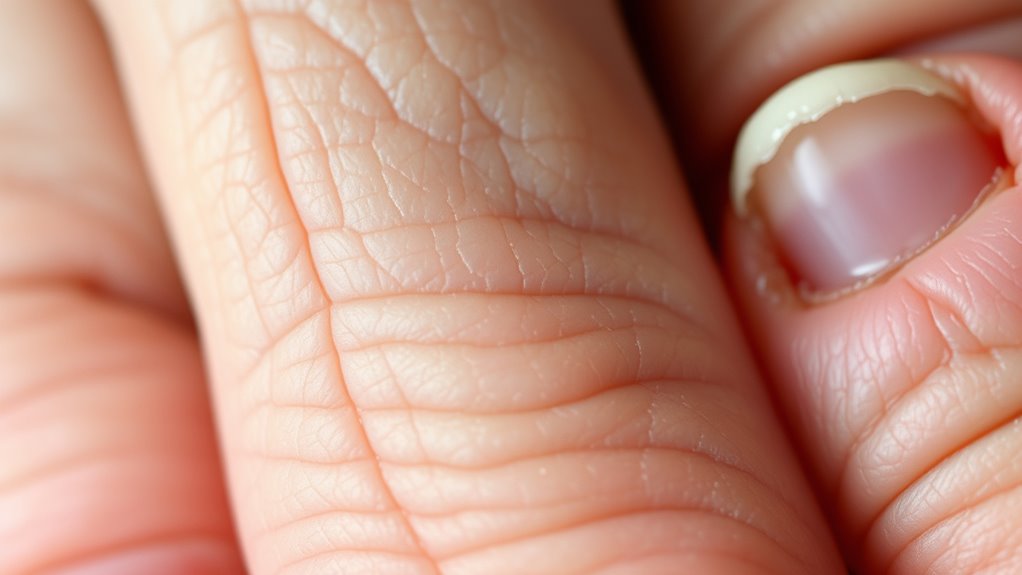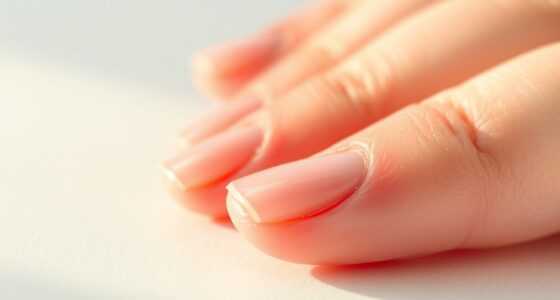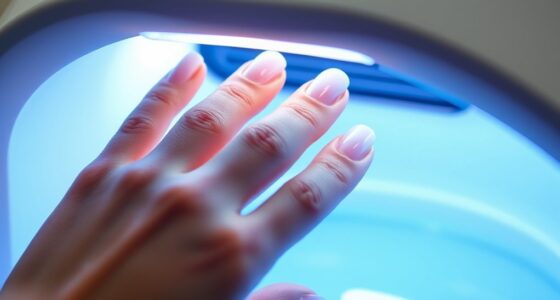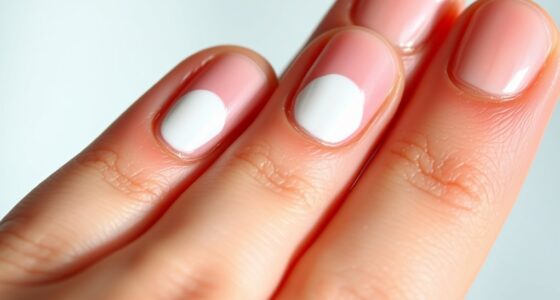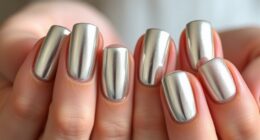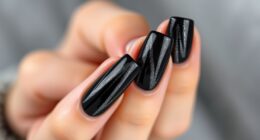As you age, your nails tend to grow more slowly, becoming thinner, brittle, and prone to splitting. Reduced circulation and decreased keratin production make your nails weaker and more irregular in texture. Nutritional changes and exposure to harsh chemicals can worsen these effects. Although these shifts are natural, signs like discoloration or pitting may indicate underlying health issues. To learn how to keep your nails healthy over time, continue exploring the facts.
Key Takeaways
- Nail growth slows with age, taking longer to reach full length.
- Nails tend to become thinner, more brittle, and prone to splitting due to decreased keratin production.
- Age-related pigmentation changes can cause darker, lighter, or uneven patches on nails.
- Circulatory decline reduces nutrient and oxygen flow, weakening nails and causing discoloration.
- Common disorders like fungal infections and psoriasis become more prevalent, affecting nail strength and appearance.
How Nail Growth Changes With Age

As you age, your nails tend to grow more slowly than they did in your younger years. This slowdown can impact your nail polishing routine and the way you showcase nail art designs. You may notice that your nails take longer to fully grow out, making it harder to achieve desired lengths for intricate designs. Thinner nails also mean that nail polishing might not last as long or adhere as smoothly. To keep your nails looking their best, focus on gentle care and avoid aggressive filing. Slower growth doesn’t mean you can’t enjoy creative nail art designs; it just requires a little more patience. Incorporating nail care tips into your routine can help maintain healthy nails despite these changes. With proper care, you can still express your style and enjoy beautiful, polished nails at any age.
Factors Contributing to Thinner and Weaker Nails

Several factors can cause your nails to become thinner and weaker over time. Frequent use of nail polish and harsh removers strips away natural oils, compromising nail strength. Visiting nail salons often exposes your nails to damaging chemicals and improper filing techniques, which can thin the nail plate. Underlying health issues, such as nutritional deficiencies or skin conditions, also contribute to fragility. Additionally, aging reduces keratin production, making nails more brittle. The table below highlights common influences:
| Factor | Effect | Prevention Tip |
|---|---|---|
| Nail polish & removers | Dehydration and weakening of the nail plate | Use gentle, acetone-free remover |
| Nail salons | Mechanical stress and chemical damage | Limit frequent visits |
| Nutritional deficiencies | Reduced keratin synthesis | Eat balanced diet |
| Aging | Natural decline in nail thickness | Maintain overall health |
| Skin conditions | Altered nail integrity | Seek dermatological advice |
The Impact of Reduced Circulation on Nail Health

Reduced circulation can markedly impact the health of your nails, especially as you age. When circulatory health declines, your nail bed circulation slows down, depriving your nails of essential nutrients and oxygen. This can lead to several emotional impacts:
- Frustration as your nails become brittle and prone to breaking, despite your efforts to care for them.
- Concern over the dull, discolored appearance that signals compromised nail bed circulation.
- Worry about the long-term effects on nail growth and strength, which can diminish your confidence.
- Recognizing that maintaining WWE Raw’s financial impact can also be linked to overall health and wellness, including circulatory health, emphasizing the importance of a holistic approach to aging well.
Poor circulation limits the supply of imperative nutrients, causing nails to weaken and grow more slowly. Maintaining healthy circulatory health is indispensable to preserving your nails’ vitality and appearance.
Age-Related Changes in Nail Composition and Texture

With age, your nails undergo notable changes in their composition and texture that can affect their appearance and strength. You might notice shifts in nail pigmentation, leading to darker, lighter, or uneven patches as melanocytes become less active. These pigment changes are natural but can sometimes signal underlying health issues. Additionally, your nails may develop surface irregularities like nail pitting — tiny depressions or indentations that appear due to decreased keratin production or minor trauma. The overall texture can become rougher or more brittle, making nails more prone to splitting or breaking. These age-related alterations don’t necessarily indicate serious problems but reflect the natural aging process affecting nail structure and pigmentation over time.
Common Nail Disorders in Older Adults

As you age, you’re more likely to encounter common nail disorders that can affect their appearance and health. These issues can be unsettling and sometimes painful. Here are three common concerns:
As you age, nail disorders may appear, affecting appearance and comfort—stay alert and seek early treatment for healthier nails.
- Nail fungus, which causes thickening, discoloration, and crumbling nails, making you feel self-conscious.
- Nail psoriasis, leading to pitting, ridges, or abnormal nail growth, impacting your confidence.
- Brittle or ridged nails, resulting from decreased moisture and collagen, making nails more prone to breaking.
These conditions are often linked to changes in your immune system, circulation, or skin health as you age. Recognizing these signs early can help you seek treatment and maintain nail health. Fostering a digital-friendly environment at home can also be beneficial in managing and educating yourself about these changes. Remember, addressing these disorders promptly can improve your comfort and appearance.
How Nutritional Needs Evolve and Affect Nails
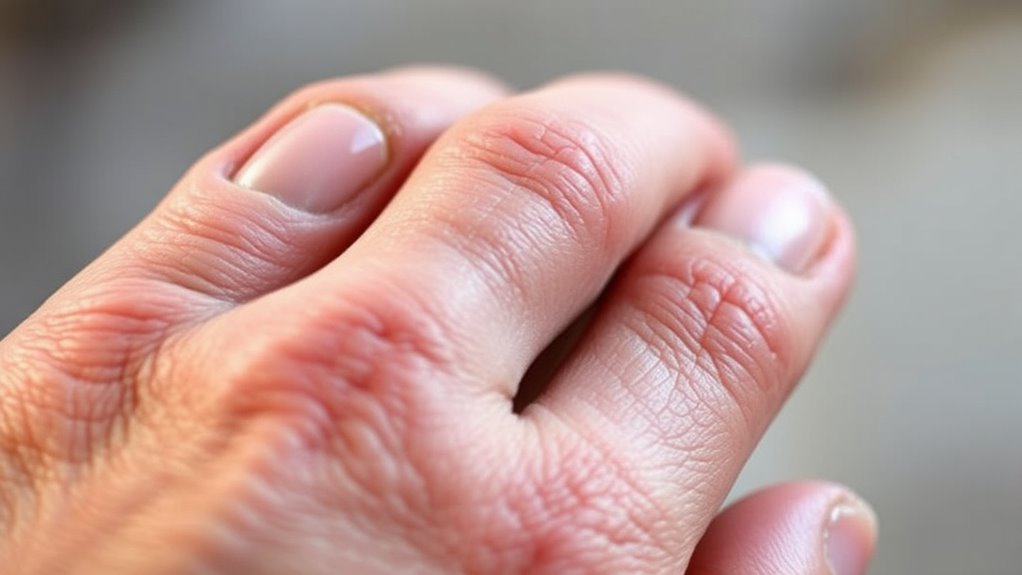
Nutritional needs change as you age, directly impacting the health and strength of your nails. As you get older, your body becomes less efficient at absorbing essential nutrients like vitamins and minerals, which are crucial for nail growth. This reduced vitamin absorption can lead to brittle, weak nails or slow growth. To combat these changes, you might consider dietary supplements that provide key nutrients such as biotin, zinc, and iron. These supplements can help fill nutritional gaps and support stronger, healthier nails. It’s important to maintain a balanced diet rich in vitamins and minerals, but supplements can ensure you’re meeting your body’s evolving needs. Additionally, understanding nutrient absorption can help you optimize your diet for better nail health. Staying proactive with your nutrition can profoundly influence the resilience and appearance of your nails as you age.
Tips for Maintaining Healthy Nails as You Age
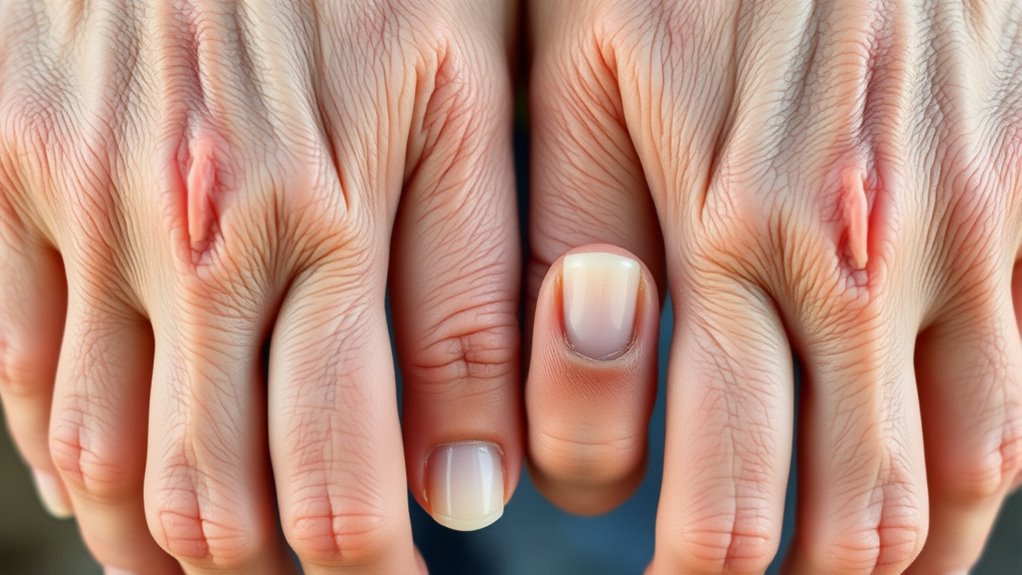
To keep your nails healthy as you age, you should moisturize regularly to prevent dryness and brittleness. Eating a balanced diet guarantees your nails get the nutrients they need to stay strong, and choosing gentle products helps avoid damage. Incorporating AI-powered analysis can help you monitor changes in nail health over time, allowing for early intervention and better maintenance of nail strength.
Moisturize Regularly
Since aging can lead to drier, more fragile nails, regular moisturizing becomes essential for maintaining their health. Proper nail hydration helps prevent brittleness and keeps your nails looking vibrant. Incorporate these simple steps into your skincare routines:
- Apply a nourishing cuticle oil daily to boost moisture directly where your nails need it most.
- Use a rich hand cream after washing your hands to lock in hydration and protect against dryness.
- Invest in a strengthening nail moisturizer that contains essential oils or vitamins to support nail resilience.
- Embracing a consistent lifestyle routine that includes regular moisturizing can significantly enhance nail health over time.
Consistent moisturizing not only improves the appearance of your nails but also prevents cracks and splits. By making these habits a part of your routine, you’ll support healthier, stronger nails as you age.
Maintain Proper Nutrition
Maintaining proper nutrition is key to supporting your nails’ health as you age. To do this, guarantee your diet includes essential nutrients like biotin, zinc, and iron, which promote strong, healthy nails. Dietary supplements can fill in nutritional gaps if your diet lacks certain vitamins or minerals. Staying hydrated is equally important; hydration strategies like drinking enough water daily help prevent brittle, dry nails. Incorporate water-rich foods such as fruits and vegetables to boost hydration naturally. Avoid excessive alcohol and caffeine, which can dehydrate you. Consistently nourishing your body with these strategies supports nail growth and strength, helping you maintain healthier nails despite aging. Proper nutrition combined with hydration is a simple yet effective way to keep your nails resilient over time. Adequate hydration is also essential, as it helps maintain nail flexibility and prevents breakage.
Use Gentle Products
As you age, choosing gentle nail products becomes essential to prevent damage and maintain healthy nails. Harsh chemicals can weaken nails and cause peeling or breakage. Focus on gentle nail care by selecting products free from formaldehyde, toluene, and acetone. To support your nails naturally, consider using natural remedies like coconut oil or vitamin E oil to nourish and strengthen. Incorporating AI tools can also assist in identifying safe and effective nail products tailored to your needs. Here are three ways to protect your nails: 1. Switch to acetone-free polish removers to reduce dryness. 2. Use moisturizing cuticle oils daily to keep nails flexible. 3. Opt for gentle, sulfate-free soaps to avoid stripping natural oils.
Recognizing Signs of Underlying Health Conditions Through Nails
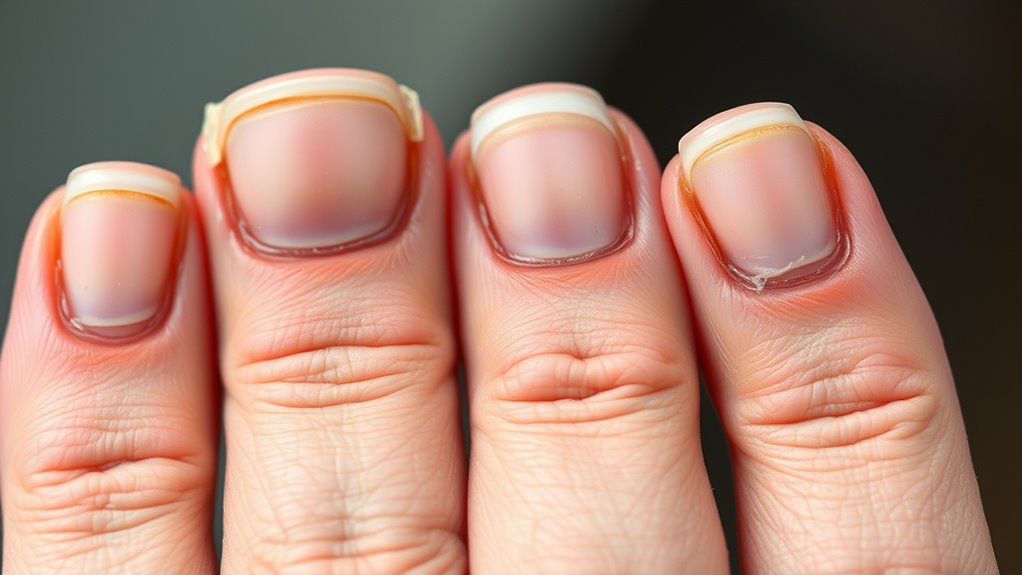
Your nails can reveal more about your health than you might realize. Changes like nail discoloration, pitting, and ridging often signal underlying health issues. For example, yellow or brown nails may indicate fungal infections or respiratory problems. White spots or lines could point to zinc deficiency or trauma. Pitting—the small depressions on the nail surface—can be linked to psoriasis or eczema, while vertical ridges may develop with aging or suggest nutritional deficiencies. Nutritional deficiencies can also manifest through changes in nail strength and growth. Recognizing these signs early helps you seek medical advice and address potential health concerns promptly. Keep an eye on persistent changes, and don’t ignore symptoms that seem unusual. Your nails serve as a window into your overall health, so paying attention can lead to early diagnosis and better care.
Frequently Asked Questions
Can Aging Cause Permanent Nail Damage?
Yes, aging can cause permanent nail damage, especially if you notice changes in nail pigmentation or decreased nail resilience. As you get older, nails may become more brittle, thin, or discolored, which might not fully reverse. These changes can be due to underlying health issues or long-term damage. To protect your nails, maintain good hygiene, stay hydrated, and see a dermatologist if you notice persistent or severe changes.
Are There Specific Vitamins That Prevent Nail Thinning?
Yes, certain vitamins and nutritional supplements can help prevent nail thinning. You should focus on dietary adjustments that include biotin, vitamin E, iron, and zinc, which support nail strength and growth. Taking these supplements regularly and maintaining a balanced diet boosts your nails’ health, especially as you age. Remember, consistent nutritional intake is key to preventing thinning and keeping your nails strong and healthy over time.
How Does Stress Affect Nail Health in Older Adults?
Stress can weaken your nails by disrupting your body’s natural processes, leading to brittle, ridged, or peeling nails. To protect your nail health, you should prioritize stress management techniques like relaxation exercises and adequate sleep. Additionally, nutritional support with a balanced diet rich in vitamins and minerals helps strengthen nails and combat stress-related damage. Taking these steps can keep your nails healthier and more resilient as you age.
Do Nail Changes Indicate Early Signs of Diseases?
Nail changes can signal early signs of diseases. If you notice nail fungus, which causes thickening and discoloration, or nail discoloration, it might indicate underlying health issues like infections or circulatory problems. Keep an eye on sudden or unusual changes, and consult a healthcare professional if you see persistent or worsening symptoms. Recognizing these early signs helps in timely diagnosis and treatment, preventing more serious health complications.
Can Aging Nails Be Reversed or Improved?
Did you know that nail growth slows by up to 50% as you age? You can improve aging nails with proper nail repair techniques and focused aging prevention. Regular moisturization, a balanced diet rich in biotin, and avoiding harsh chemicals help maintain nail health. While you can’t fully reverse aging effects, these steps support stronger, healthier nails, making it possible to enhance their appearance and strength over time.
Conclusion
As you age, your nails reveal more than you might realize—signs of your body’s changing health and needs. Staying attentive to these subtle shifts can uncover hidden issues before they become serious. Will your nails tell you what’s really going on inside? Keep an eye on their changes, nourish them well, and stay proactive. The clues are there—are you ready to uncover what your nails are trying to tell you?
